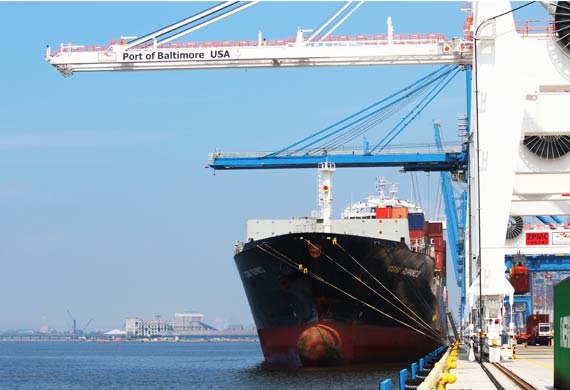
Soaring high
In an era of globalisation, the Port of Baltimore, seeks to consolidate its position as the number one hub for automobile imports and exports. Lionel Alva… The Port of Baltimore’s storied past, once saw it as a prosperous hub bustling with activity and since then it has fast adapted to changing economic environments. Over 300 years, […]

In an era of globalisation, the Port of Baltimore, seeks to consolidate its position as the number one hub for automobile imports and exports. Lionel Alva…
The Port of Baltimore’s storied past, once saw it as a prosperous hub bustling with activity and since then it has fast adapted to changing economic environments. Over 300 years, the Port of Baltimore has grown from a port of entry for the state’s tobacco trade with England to a primary gateway moving goods such as automobiles, tractors, paper, toys, coal, sugar, and clothing. Now, amidst an era of port automation, containerisation and globalisation, the Port of Baltimore, seeks to consolidate its position as the number one hub for automobile imports and exports. Its significance in both strategic and geographic terms hasn’t diminished.
Since becoming the port of entry for the first Volkswagen Beetle in 1963, the Port of Baltimore has delivered top rate automobile service and handling capabilities. Today, more than half a million automobiles move through Baltimore’s public and private terminals each year.
The Fairfield area of the port includes four specialised terminals for handling and processing autos, light trucks and similar ro/ro cargo. Currently, portions of the port are leased to Daimler-Chrysler (Mercedes-Benz) and Auto Warehousing Corporation (AWC). These specialised terminals process autos and light trucks. Typically, this includes accessorising, minor repair operations and final dealership preparation. The terminal is adjacent to a public berth, also owned by MPA. A vessel discharging new vehicles can berth within a few hundred feet of the facility.
“The Port of Baltimore is the closest East Coast port to the Midwest. This means cargo can travel to and from Baltimore to Midwest markets quicker and more cost-effectively than other ports. The Port of Baltimore is located right off Interstate 95, the main street of the U.S. East Coast, and is within minutes of a major highway linking to the Midwest. The Port of Baltimore also has two Class A railroads on-dock,” avers Richard Scher, Director of Communications, Port of Baltimore.
The port has successfully outperformed various other US ports owing to smart decision-making and investments, unique job-creating public-private partnerships and long-term contracts with other major international shipping companies, despite turbulent economic times.
“The Port of Baltimore is one of Maryland’s most important economic assets, and it will play an integral role in our efforts to help grow the state’s economy,” Governor Larry Hogan said in a news release. “My administration is focused on building Maryland’s reputation as a place that’s ‘Open for Business,’ and the port can play a pivotal role in spreading this message while also delivering real economic growth,” the governor added.
The Port of Baltimore consists of public marine terminals owned by the Maryland Port Administration (MPA) and private marine terminals. Bulk cargos such as coal, salt and sugar are handled primarily at the privately owned terminals. 71 percent of all international cargo moving through the Port of Baltimore is in the form of bulk cargo. Combining both the public and private marine terminals, the Port of Baltimore saw 29.5 million tonnes of international cargo cross its docks last year which was valued at approximately $52.5 billion. Baltimore is ranked as the top port among all the US ports for handling autos and light trucks, farm and construction machinery, imported forest products, imported sugar, and imported aluminum. Overall Baltimore is ranked ninth for the total dollar value of cargo and 13th for cargo tonnage for all US ports. Business at the Port of Baltimore generates about 14,630 direct jobs, while about 108,000 jobs in Maryland are linked to port activities. The Port is responsible for $3 billion in personal wages and salary and more than $300 million in state and local taxes.
Ostensibly, The Port of Baltimore’s long-term strategy for success has been founded on maintaining broad capabilities for handling diverse types of cargo.
“In 2014, the Port of Baltimore opened a new auto berth at its Masonville/Fairfield Marine Terminal. The new berth is 1,175 feet in length and 130 feet wide. The new berth can support 1,000 pounds per square inch and is equipped to handle rail transport. The Port of Baltimore last year handled more than 750,000 cars, the most among any US port,” adds Scher.
The new berth could drive more automobile shipping to the city. The port opened the $22 million berth at its Masonville/Fairfield Marine Terminal that will be used to load and unload cars and trucks to and from the US. It supplants another berth that had been operating for more than 70 years.
The port’s cargo business purposely encompasses a variety of commodity markets, and the port’s competitive position is somewhat different in each. The containerised cargo market is the largest of the general cargo categories, and is the most challenging for Baltimore. In the container market, ocean carriers may be the primary players in port selection, and proximity to the ocean has become increasingly important to them. In other markets, like automobiles, roll-on/roll-off (Ro/Ro) cargo, and forest products, port selection is more often determined by the cargo interests - manufacturers, importers, or distributors - rather than by the shipping lines. For these companies, factors where Baltimore has more advantages include proximity to inland markets, efficient highway and railroad connections, damage-free cargo handling and specialised terminal facilities. The port continues to evolve as it embarks up on a journey to be counted among the best ports in the US.

